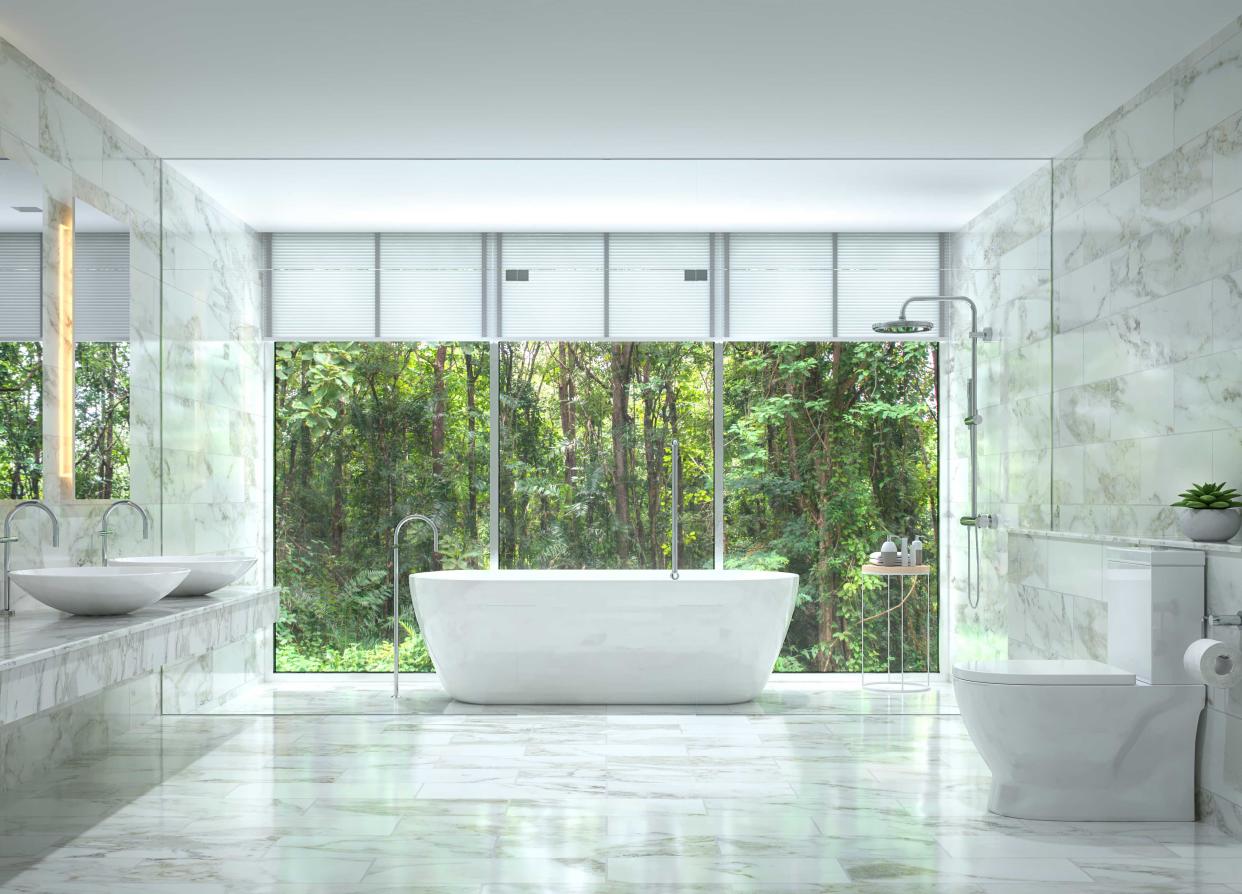Wet Rooms Are the Dreamy Decor Trend Taking Over Pinterest
For many, the pandemic has engendered radical (and sometimes necessary) changes to our homes. Playrooms have become classrooms, and kitchen tables have become conference areas. But perhaps one of the biggest home trends to emerge from COVID-19 is transforming our blasé bathrooms into spa-like environments that promote self-care and serenity. Last week it was bathtubs in the bedroom, and this week, wet rooms are taking Pinterest feeds by storm. So what is a wet room, exactly? Here, we’ll break down the trend and provide some pros and cons to consider before your next reno.
RELATED: This Bathroom Style Is Trending on Pinterest, But It Can Be Very Polarizing

Getty Images/alvarez
WHAT ARE WET ROOMS?
Basically, wet rooms are minimally designed, open-concept bathrooms. The look generally includes an open, tiled bathing area with a large drain that’s—usually—in the center of the space. It’s meant to be ultra-minimalistic and excludes the use of bath mats, glass doors or shower screens (adios, unseemly shower curtains). In some variations, the entire bathroom—including floors, walls and ceilings—is tiled to be 100 percent water-resistant. But we’re seeing a more popular iteration, which encloses a free-standing tub and shower space behind a glass partition (see below).

Getty Images/runna10
In this case, all of the bathroom’s vanities, toilets and dressing areas are positioned on the other side of the enclosure. The final look serves as a happy medium between open concept bathing and functionality (because no one wants to brush their teeth in a puddle of water).

Getty Images/Serhiy Stakhnyk
OK…SO WHERE DID THIS IDEA COME FROM?
The wet room or open-bathroom concept is derived from Japanese design, where the typical bathroom consists of a shower and bathtub. All sinks, vanities and toilets are almost always located in a separate room. “It’s quite taboo to have the toilet in the same room where you get clean and relax,” writes Alyssa Sellors for BlogCritics.com, a lifestyle and culture site. “Bathing in Japan is a daily ritual for many, one that is done to relieve stress and promote health.”
In America, wet rooms were initially implemented in the 1960s as a small-space solution for tiny bathrooms. Unlike today’s sprawling, open-floor bathrooms, the earlier editions of the open bathroom were far more simplistic and sustainably minded. People wanted to maximize their space and conserve energy in the most efficient way possible. It wasn’t until 2013 that wet rooms took a turn toward the luxurious.
WET ROOMS: PROS AND CONS

Getty Images/Martin Barraud
1. PRO: BATHROOMS FEEL BIGGER
A major draw to the wet room—and Japandi design, in general—is the ‘less is more’ approach to large uninterrupted spaces. Since the look forgoes extras (i.e., mats, doors, hooks or curtains), you’re left with a clean room that feels infinitely larger. As we mentioned before, wet rooms serve as a practical design choice for small spaces. But that doesn’t mean the look is synonymous with tiny bathrooms. Pinterest-favorite wet rooms are far more lavish with multiple vanities, showerheads and sophisticated metal finishes. Still, the actual size of the bathroom is irrelevant. A wet room is guaranteed to give your space a sleek look with some extra floor space.
2. PRO: LUXURY AND SERENITY IN THE SAME PLACE
One of the core principles behind the wet room is an indoor-outdoor connection to nature—fitting, considering that’s one of the biggest design trends of 2021. The wet room trend arrives on the heels of COVID-19 after a collective struggle to find serenity and relaxation while locked down at home. Sellers says most Japanese wet rooms use “soft brown and gray walls, silver, white and black appliances and smooth granite surfaces” to mimic elements of nature. Sellers also says you can bring in “faucets that replicate the flow and sound a rushing waterfall” and “smooth beach pebbles in place of titled floors or walls” for a similar effect.
3. PRO: IT INCREASES PROPERTY VALUE
According to a Fixr report, “Bathroom remodels currently recoup between 56 and 70 percent, depending on the level of quality of the materials.” It also mentioned that “because wet rooms often use higher quality materials and are considered a luxury addition, they may recoup slightly more at time of resale.” That said, it’s worth mentioning that a wet room itself isn’t guaranteed to increase property value and “most homeowners want to have at least one conventional bathroom in the house.” However, if you’re planning a master bathroom upgrade, we’d say a luxurious wet room will definitely be alluring to buyers.

Getty Images/sihuo0860371
4. CON: EXPENSIVE MATERIALS AND INSTALLATION
The report also mentions that wet rooms cost about 20 to 30 percent more than a traditional bathroom renovation. This is mostly because waterproofing the space can be expensive, and materials are harder to find. Plus, there’s the issue of flooring, where a wet room floor must slope at a certain angle to ensure the water is drained properly. “This means using 2-inch or smaller tiles throughout most [of the room] or switching to a smaller tile in the pattern as you approach the slope of the drain.” As a result, the average cost of materials and installation is around $150 a square foot. That means that a 144-square foot wet room would cost about $21,600, according to the report.
